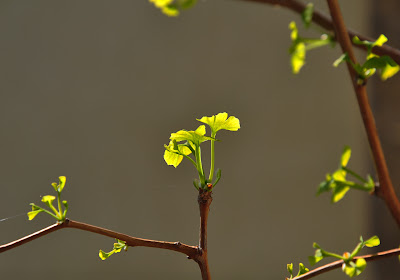I keep a few mature Trichocereus plants that are moved out on the balcony come spring. While the Trichocereus peruvianus (Peruvian Torch cactus) and Trichocereus bridgesii plants usually take the transition to being exposed to the elements in stride, I always have to look out for my Trichocereus pachanoi (San Pedro cactus) not to get sunburned. Like in humans sunburn in cacti is the result of an inflammation/damage of the epidermis caused by excessive exposure to ultraviolet (UV) radiation from sunlight; typically most severe in new growth.

San Pedro cactus developing a sunburn
Consequently I aim to introduce the tender Trichocereus pachanoi gradually to full sun. This spring I made sure to place the San Pedro in an area that lies in shade most of the day. I even heeded the weather reports and moved the plants indoors on sunny days. Still the San Pedro is developing a sunburn in the new growth area facing the sun - interestingly it doesn't seem to get sunburned at the growing point at the tip but always a bit down the side from it, probably because of the steeper angle of incidence of the sun rays and UV radiation.

Undamaged, bright green new San Pedro growth
More severe burns turn into unbecoming, hard tan scars as illustrated by the below picture of last years burn (where I thoughtlessly moved the plants out and placed them in a sunny spot without observing them for a couple of days).

Trichocereus pachanoi with sunburn from last year
A light sunburn can be outgrown but the hard scars are permanent.
I'll end this post on a more positive note with the image below of a Ginkgo biloba happily setting new leaves :-) The Ginkgo biloba grows on the balcony year-round.

Ginkgo biloba ushering in spring
Sunday, May 19, 2013
Sunburned San Pedro cactus (Trichocereus pachanoi)
Tuesday, May 07, 2013
Trypophobia - fear of holes
_seed_pod_20090905.jpg)
Trypophobia inducing seed head of sacred lotus (Nelumbo nucifera)
A few weeks ago I was contacted by Arnold Wilkins, professor in psychology at the University of Essex, who sought permission to reproduce the above image of a lotus seed pod in a scientific publication on trypophobia. I had never heard about trypophobia before but a quick investigation revealed that the term was coined recently, combining the Greek trypo (punching, drilling, or boring holes) and phobia (an extreme or irrational fear of or aversion to something). Research on trypophobia is still limited and the condition is not recognized in the American Psychiatric Association's Diagnostic and Statistical Manual of Mental Disorders. Still, thousands of people claim to be fearful of objects with small holes, such as beehives, ant holes, and lotus seed heads. There's even a website dedicated to trypophobia with loads of pictures of stuff with holes in it. Trypophobia is also called repetitive pattern phobia.
I always found my lotus seed pod image nothing but beautiful and couldn't (still quite can't) understand that a picture like this would cause anxiety in anybody. Anyway it will soon appear in an academic article on trypophobia and I'll bring an update when it's published.
I know it's entirely unscientific but I set up the poll below to get a better understanding of how many people are actually disturbed by the sight of the lotus seed head:
The image originally appeared in a post on Brooklyn Botanic Garden.
All Time Most Popular Posts
-
Lophophora williamsii (peyote) populations have diminished in large areas of South Texas where peyoteros harvest the cactus for ceremonial ...
-
On various occasions I've been asked what growing media I'm using for my cactus plants. I don't have a set soil mix recipe as su...
-
Below is a list of retailers/nurseries selling cactus seed and plants. I've only listed vendors I've done business with. If you ar...
-
Most cacti are easily grown from seed - and with a little patience and care they can be grown into beautiful plants. Lophophora williamsi...
-
In last month’s post on the troubled Texan peyoteros I referred to Anderson’s article on the peyote situation in Texas. Given the importanc...
-
Yet another slightly off topic and probably not entirely politically correct post, but I couldn’t help noticing the similarity of my monstr...
-
Flowering stand of San Pedro cacti (Trichocereus pachanoi) To me the main draw of the San Pedro cactus ( Trichocereus pachanoi (syn. Ech...
-
In the June 2008 issue of the Cactus & Co magazine Jaroslav Šnicer, Jaroslav Bohata, and Vojtěch Myšák described a new Lophophora spec...
-
There seems to be an increased focus on the alarming Texas peyote situation. A couple of weeks ago the Houston Press published a mournful, i...
-
I spent two weeks working in Delhi, India during January. I had one weekend off and had planned to spend it in Delhi at my own leisure, but ...


















